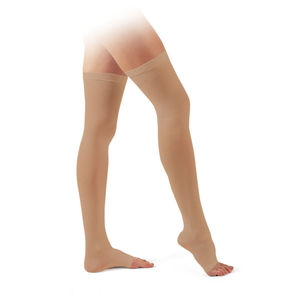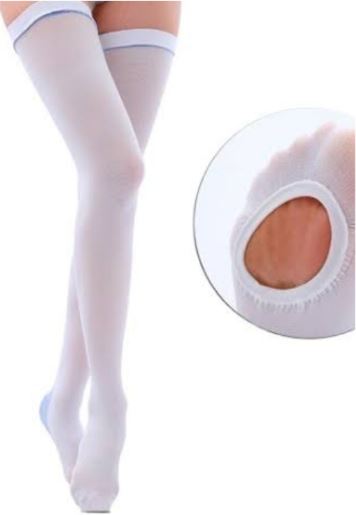COMPRESSION STOCKING, class II, single patient, pair, L
Valid Article
COMPRESSION STOCKING
Definition
A garment in the form of a sock or stocking intended to fit tightly over the leg and foot to apply compression/pressure (i.e., graduated or even-force), typically for the treatment/prevention of a disorder(s) of circulation [e.g., venous insufficiency, deep vein thrombosis. It is not a strip/roll binder or tubular support bandage, and is not designed to cover the pelvis. It is typically made of elastic material (e.g., circular knit nylon/Spandex yarns); it does not include antimicrobial features. It is intended for use in the home or a clinical setting. This is a single-person-use device.
Specifications
4 classes based on their pressure value
- Class 1 : 18-21 mm Hg / 2.4-2.8 kPa; Light pressure with a superficial drainage system of moisture and waste. This class applies for/to people with:
- heavy and tired legs,
- a light form of varicose veins,
- preventive wear during pregnancy,
- a slight tendency to oedema
- Class 2 : 23-32 mm Hg / 3.1-4.3 kPa. Moderate pressure with a superficial drainage system of moisture and waste. This class applies for/to people with:
- varicose veins,
- swollen legs during pregnancy,
- operations of varicose veins,
- a treatment of vein problems,
- a slight tendency to oedema
- Class 3 : Strong pressure with a superficial and deep drainage system of moisture and waste. This class applies for/to people with:
- varicose veins due to damaged deep veins,
- chronic venous insufficiency,
- early stage lymphoedema,
- a strong tendency to oedema
- Class 4 : Very strong pressure with a superficial and deep drainage system of moisture and waste. This class applies for/to people with:
- very severe venous diseases,
- advanced lymphoedema.
Quality Standards Comment
For a neutral and reproducible testing method in Europe for medical compression stockings, couple of standards have been developed like in Germany RAL-GZG standard, in France AFNOR and in Great Britain BSI. These standards include exactly defined procedures how to classify a medical compression stocking. Preliminary ENV 12718 was created as a mutual European standard, but in the end it was refused by the majority of the members of the standardization committee after 13 years. Only the German standard RAL-GZG took over the reasonable requirements of the ENV 12718.
Technical specifications
Length: Tigh high (AG): 64-75 cm
Circumference measurements: unit cm
| Size | S | M | L | XL | XXL |
| CB | 18-21 | 21-24 | 23-26 | 26-30 | 30-33 |
| Cb1 | 23-26 | 25-30 | 29-33 | 32-36 | 35-39 |
| CC | 30-34 | 33-38 | 37-40 | 39-43 | 42-46 |
| CD | 28-33 | 32-36 | 35-39 | 38-42 | 41-45 |
| CE | 32-35 | 34-38 | 37-41 | 40-45 | 44-49 |
| CF | 40-43 | 42-47 | 46-50 | 49-53 | 42-56 |
| CG | 46-50 | 49-55 | 54-59 | 58-60 | 61-64 |
| CT | 75-90 | 85-100 | 95-110 | 100-115 | 105-120 |
Dimensions
Instructions for use
MSF requirements
Indicated in patients at risk for venothromboembolism who have contra-indications to chemical thromboprophylaixs with heparin or low molecular weight heparin (LMWH) e.g. due to bleeding risks.




